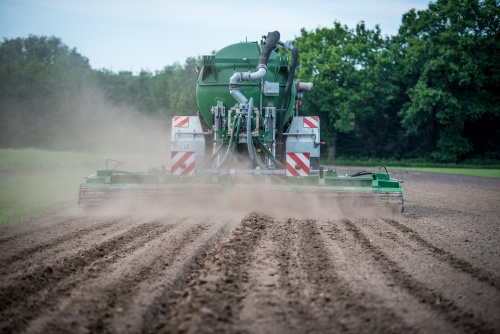Agri-environmental indicator - tillage practices
Data extracted in July 2020.
Planned update: 2025
Highlights
Conventional tillage was the most wide-spread tillage practice in EU-27 in 2016, applied on two-thirds of the total arable area, implying intensive ploughing and harrowing which can have negative impacts on the environment.
In 2016, Portugal reported the highest decline in the share of conventional tillage practices in tillable area, Romania in absolute terms, compared with 2010.
The majority of tillable area in Cyprus and Portugal was under conservation tillage in 2016.
This article provides a fact sheet of the European Union (EU) agri-environmental indicator tillage practices. It consists of an overview of data, complemented by information needed to interpret these data. This article on tillage practices in the EU is part of a set of similar fact sheets, providing a comprehensive picture of the integration of environmental concerns into the Common Agricultural Policy (CAP).
Tillage practices refer to the soil treatment of arable land carried out between the harvest and the following sowing/cultivation operation. Intensive ploughing and harrowing can have negative environmental impacts, like pesticide and nutrient runoff, soil erosion, soil compaction and loss of organic matters. In order to prevent erosion and degradation and to preserve soil biodiversity, it is important to reduce soil disturbance through reduced or no tillage.
Full article
Analysis at EU level
Conventional tillage was the most wide-spread tillage practice in the EU in 2016
Tillage practices can be distinguished in three methods: conventional tillage, conservation tillage and zero tillage. Conventional tillage involves intensive ploughing and harrowing with a tractor, which leads to a total inversion of the soil. Conservation tillage, on the other hand, tries to minimise soil disturbance and leave most of the crop residues on the surface. Zero tillage means that the soil is not tilled at all.
Figure 1 shows the share of the three tillage practices in the EU-27 in 2016. Conventional tillage was the most wide-spread tillage practice in the EU. Two-thirds of the arable area was tilled with conventional tillage practices, while almost a fifth was tilled with conservation practices, and zero tillage was rarely applied (left pie chart). A similar picture emerges focussing only on tillable area (right pie chart).
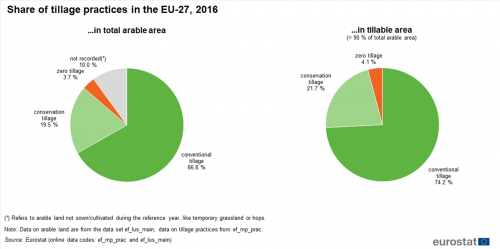
Source: Eurostat (ef_mp_prac) and (ef_lus_main)
Conservation and zero tillage was practised mainly on large farms in the EU in 2016
The size of the holding seems to influence the tillage practices applied on the land (Figure 2)[1]. More than half of the arable land, 54.0 %, belongs to large farms (≥100 ha) and a proportionally larger share (72.3 %) of the area on which conservation or zero tillage is applied is found on these farms.
Small farms (<20 ha) managed 16.8 % of the arable land (Figure 2). These farms counted a slightly larger share of the area conventionally tilled (20.1 %), and a smaller share under conservation/zero tillage (6.4 %). Lastly, 21.3 % of the land under conservation or zero tillage was found on medium-sized farms, which manage 29.2 % of the arable land. Of the land managed with conventional tillage, 31 % was found on medium-sized farms.
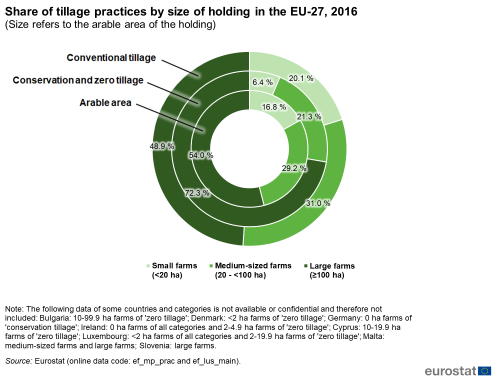
(Size refers to the arable area of the holding)
Source: Eurostat (ef_mp_prac) and (ef_lus_main)
Analysis at country level
In Cyprus, conservation tillage practices covered half of the arable land in 2016
Figure 3 shows the share of total arable area tilled with conventional, conservation and zero tillage for the EU-27 in 2016 on country level. In addition, it contains the arable area for which tillage practices are not recorded, eg for multi-annual plants. This applies especially to countries with high shares of temporary grassland (eg Ireland, Latvia, the Netherlands, Finland and Sweden)[2]. In Malta, all arable land under tillage was tilled with conventional tillage practices, while in Cyprus more than half of the arable land was tilled by conservation practices. Estonia had the highest share of zero tillage in arable land (11 %).
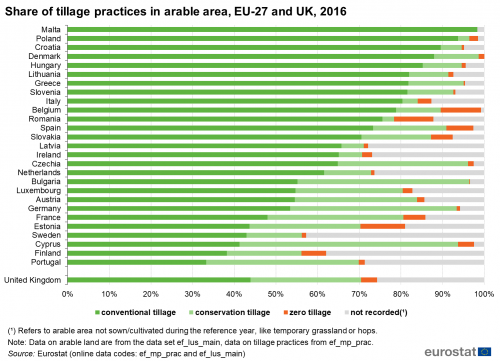
Source: Eurostat Source: Eurostat (ef_mp_prac) and (ef_lus_main)
The highest shares of conventional practices in tillable area in 2016 were in Malta, Poland, Croatia, Italy and Latvia
Figure 4 refers only to the tillable area of arable area. In 2016, the highest shares of conventional tillage of more than 90 % were in Malta, Poland, Croatia, Italy and Latvia. The only countries where the majority of tillable area was under conservation tillage were Cyprus (54 %) and Portugal (51 %). High shares of conservation tillage practices were also reported for Bulgaria (43 %) and Germany (42 %). Zero tillage practices were generally very low ranging from 0 to 13 % with the highest shares of ≥ 10 % in Estonia, Romania, Belgium and Finland.
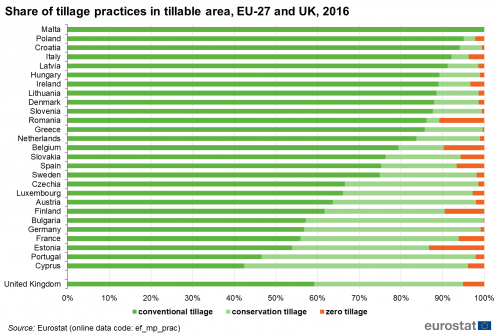
Source: Eurostat (ef_mp_prac)
Portugal reported the highest decline in the share of conventional tillage, Romania in absolute terms
Comparing the change in share of tillage practices in tillable area in the EU between 2010 and 2016, it turns out that it remained rather stable at EU-level, whereas large differences can be identified at country level (Figure 5). Portugal performed a large-scale conversion of conventional tillage to conservation tillage with a significant increase of +31.8 p.p. in conservation tillage practices. However, in absolute terms, Germany and France reported the highest increase in conservation tillage by more than 1 million hectares each. Romania reported the highest decline in conventional tillage of almost 1 million hectares. On the other side, in some countries conventional tillage practices increased since 2010. This applies on a larger scale to Bulgaria (+15.2 p.p.), Poland (+14.5 p.p.) and Greece (+8.3 p.p.). In absolute terms, Poland revealed by far the highest increase in conventional tillage with more than 6 million hectares. The most significant change in shares regarding zero tillage occurred in Belgium (+9.6 p.p.) and in absolute terms in France (increase of >400 000 ha).
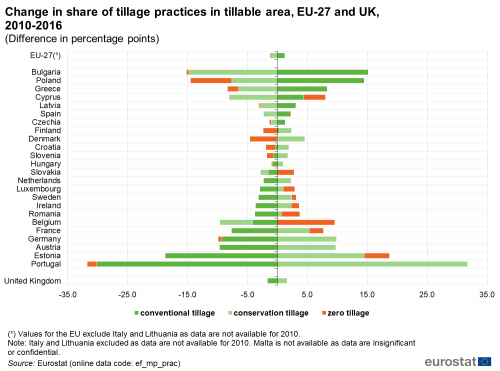
Source: Eurostat (ef_mp_prac)
Analysis at regional level
Alentejo in southern Portugal reported the highest share of conservation tillage in tillable area in 2016
In almost half of the regions at NUTS 2 level, conventional tillage was applied on more than 80 % of the tillable area in 2016 (Map 1). Considering only regions with large arable areas of ≥800 000 ha, the regions with the highest shares (90 %) of conventional tillage could be found in Croatia (Kontinentalna Hrvatska), Italy (Emilia-Romagna), Latvia, Hungary (Észak-Alföld and Dél-Alföld), Poland (Mazowieckie, Lubelskie, Kujawsko-Pomorskie and Wielkopolskie) and Romania (Észak-Alföld).

Source: Eurostat (ef_mp_prac) and (ef_lus_main)alt= a map showing the share of conventional tillage in tillable area by NUTS 2 regions in the EU-27 and the UK for the year 2016.
The shares of tillable area on which conservation tillage was applied in 2016 varied from 0 % in Malta and Italy (Valle d'Aosta, Liguria, Provincias Autonomas di Bolzano and Trento) to 76 %. The highest shares ≥65 % were reported in eastern Germany (Thüringen, Chemnitz and Sachsen-Anhalt) and Portugal (Alentejo and the island Madeira) (Map2).

Source: Eurostat (ef_mp_prac) and (ef_lus_main)alt= a map showing the share of conservation tillage in tillable area by NUTS 2 regions in the EU-27 and the UK for the year 2016.
The share of zero tillage practices ranged only from 0-28 %. Highest shares of ≥20 % were observed in the NUTS 2 regions Province Luxembourg in Belgium, Provincia Autonoma di Bolzano in Italy and Helsinki-Uusimaa in Finland (Map 3).
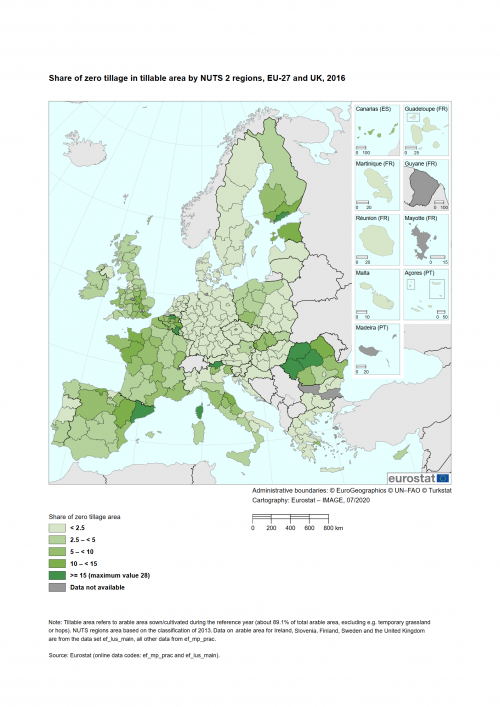
Source: Eurostat (ef_mp_prac) and (ef_lus_main)
Source data for tables and graphs
Data sources
Indicator definition
Tillage practices refer to the soil treatment of arable land carried out between the harvest and following sowing/cultivation operation. Three tillage methods can be distinguished: conventional tillage, conservation tillage and zero tillage.
Main indicator
- Arable areas under conventional tillage, conservation tillage and zero tillage.
Supporting indicator
- Share of arable areas under conventional, conservation and zero tillage.
- Share of tillable area under conventional, conservation and zero tillage.
Special aspect:
- Share of arable area under conventional and conservation and zero tillage by size of holding.
Links with other indicators
This indicator has links to a number of other AEI indicators that describe developments in some of the main contributory factors:
Data used
Data about tillage practices and arable area are available from the Farm Structure Surveys (FSS) on NUTS 0 and NUTS 2 level. They are not regularly collected.
Data sources in Eurobase:
The legal basis for the FSS from 2010 onwards is Regulation (EC) No 1166/2008 of 19 November 2008 on farm structure surveys and the survey on agricultural production methods, which repealed Council Regulation (EEC) No 571/1988. The FSS are conducted consistently throughout the EU with a common methodology at a regular base and provide therefore comparable and representative statistics across countries and time, at regional levels (down to NUTS 3 level). Every 3 or 4 years the FSS is carried out as a sample survey, and once in the ten years as a census. The basic unit underlying the FSS is the agricultural holding. The FSS covers all agricultural holdings with UAA of at least one hectare (ha) and also those holdings with UAA of less than 1 ha where their market production exceeds certain natural thresholds. Although the thresholds for defining an agricultural holding can be different between countries (as high as five hectares of UAA in some cases), it has been ensured that the survey covers 98 % of the UAA and the livestock of each country. For more information see the metadata file ef_esms.
Methodology
The indicator is mature and no conceptual or modelling development is needed.
Tillage practices refer to the tillage operations carried out between the harvest and following sowing/cultivation operation. Data on tillage practices were collected for the arable area sown/cultivated during the reference year. The article refers to the area as 'tillable area'. Only the area of main crops is included. Multi-annual plants like temporary grassland, leguminous plants, industrial crops (hops or aromatic plants) etc. were excluded from the survey and covered separately in the category 'not recorded' (see e.g. Figure 1 and 3), which covers about 10 % of the total arable area. In addition, also kitchen gardens and area under glass or other (accessible) protective cover are excluded, as well as permanent grassland and permanent crops that do not belong to arable areas.
The sum is composed as follows:
∑ (conventional tillage + conservation tillage + zero tillage) = arable land – arable land not sown/cultivated during the reference year.
Context
Conservation agriculture encompasses a set of complementary agricultural practices which minimise alteration of the composition and structure of the soil, safeguarding it against erosion and degradation, and preserving soil biodiversity[3]:
- permanent soil cover (cover crops, residues and mulches) to protect the soil and contribute to the suppression of weeds;
- minimal soil disturbance (through reduced or no-tillage) in order to preserve soil structure, soil fauna and organic matter;
- diversified crop rotations and crop combinations, which promote soil micro-organisms and disrupt plant pests, weeds and diseases.
Conservation agriculture is commonly called conservation tillage. Some specific practices of conservation tillage include direct sowing (also called direct drilling or no-tillage), reduced tillage (also called mulch tillage or minimum tillage), zone, strip or row tillage, surface incorporation of crop residues and cover crops. These are tillage methods that leave most of the crop residues (plant material remaining after harvest) on the surface, which may be also covered by spontaneous vegetation or by sowing appropriate species. The main difference between conventional cultivation methods (conventional tillage) and simplified cultivation techniques is in the lack of inversion ploughing. Furthermore, fragmentation and disturbance are greatly reduced in simplified cultivation techniques. Soil fragmentation decreases from deep reduced tillage to direct sowing (Table 3)[4].
The information about tillage practices helps assess other indicators as such on soil cover, risks of nitrate leaching, and organic matter of soils. Any disturbance of soils may enhance turnover of nutrients and thereby increase the potential risk of loss of, for example, nitrogenous compounds and phosphorus through surface runoff and soil erosion. In particular, tillage in the autumn may increase the potential risk of losses during the following winter period. On the other hand, reduced tillage may in the short term lead to increased use of herbicides in order to compensate for the reduced mechanical weed control. Further, reduced tillage may contribute to carbon sequestration in soil and thereby may alter the emissions of greenhouse gases (GHG), especially CO2 and N2O[5].
Reduced tillage and no-tillage can potentially reduce the need for labour hours by 30-40 and 50-75 % respectively, depending on the geographical location (northern or southern Europe). Similarly, consumption of fuel can realistically drop by 10-20 % (up to 50 %) and 25-35 % (up to 60 %) for reduced tillage and no-tillage respectively. Nevertheless, switching to conservation agriculture might require significant capital investment (for example, in sowing equipment) and greater attention in the use of chemicals (that is for weeding). Furthermore, conservation agriculture is a complex, site-specific farming system, requiring training of farmers and adaptation to local circumstances before maximum economic benefits can be obtained. The practices forming the basis for conservation agriculture are also (individually) used in other farming systems (e.g. conventional, organic)[6].
Policy relevance and context, including Agri-environmental context
Tillage, crop rotation and soil cover are practices related to pesticide and nutrient runoff, soil erosion, soil compaction etc. The same policies relevant for soil cover are relevant in the context of tillage practices, see the description in the article for Agri-environmental indicator - soil cover.
Direct access to
- Agri-environmental indicators - online publication
- Agri-environmental indicators - fact sheets
- Agriculture (agr), see:
- Farm structure (ef)
- Farm land use by NUTS 2 regions (ef_landuse)
- Main farm land use by NUTS 2 regions (ef_lus_main)
- Management and practices (ef_mp)
- Agricultural practices (ef_mp_prac)
- Agriculture, forestry and fishery statistics - 2018 edition
- Agriculture, forestry and fishery statistics - 2019 edition
- Farm structure survey metadata: ef_esms
- Commission Communication COM(2006)508 final - Development of agri-environmental indicators for monitoring the integration of environmental concerns into the common agricultural policy
- Commission Staff working document accompanying COM(2006)508 final
- European Commission - Common Agricultural Policy (CAP)
- DG Agriculture and Rural Development: Agriculture and soil protection
- DG Environment: Soil
- Joint Research Centre (JRC): EUROSOILS - European Soil Portal
Notes
- ↑ The following data of some countries and categories is not available or confidential and therefore not included: Bulgaria: 10-99.9 ha farms of 'zero tillage'; Denmark: <2 ha farms of 'zero tillage'; Germany: 0 ha farms of 'conservation tillage'; Ireland: 0 ha farms of all categories and 2-4.9 ha farms of 'zero tillage'; Cyprus: 10-19.9 ha farms of 'zero tillage'; Luxembourg: <2 ha farms of all categories and 2-19.9 ha farms of 'zero tillage'; Malta: medium-sized farms and large farms; Slovenia: large farms.
- ↑ For comparison, figures on temporary grassland can be found in the data set ef_lus_allcrops in Eurostat's database Eurobase.
- ↑ JRC, 'Sustainable agriculture and soil conservation' (SoCo) project, Fact sheet 5 Conservation Agriculture
- ↑ Louwagie G.et all, 2009. Addressing soil degradation in EU agriculture. Relevant processes, practices and policies. Report on the project ‘Sustainable Agriculture and Soil Conservation (SoCo)’. Available here.
- ↑ e.g. Six, J., Ogle, S.M., Breidt, F.J., Conant, R.T., Mosier, A.R., Paustian, K. 2004. The potential to mitigate global warming with no-tillage management is only realized when practised in the long term. Global Change Biology, 10, 155–160
- ↑ Louwagie G., et al., 2009. Final report on the project ‘Sustainable Agriculture and Soil Conservation (SoCo). Available here.
